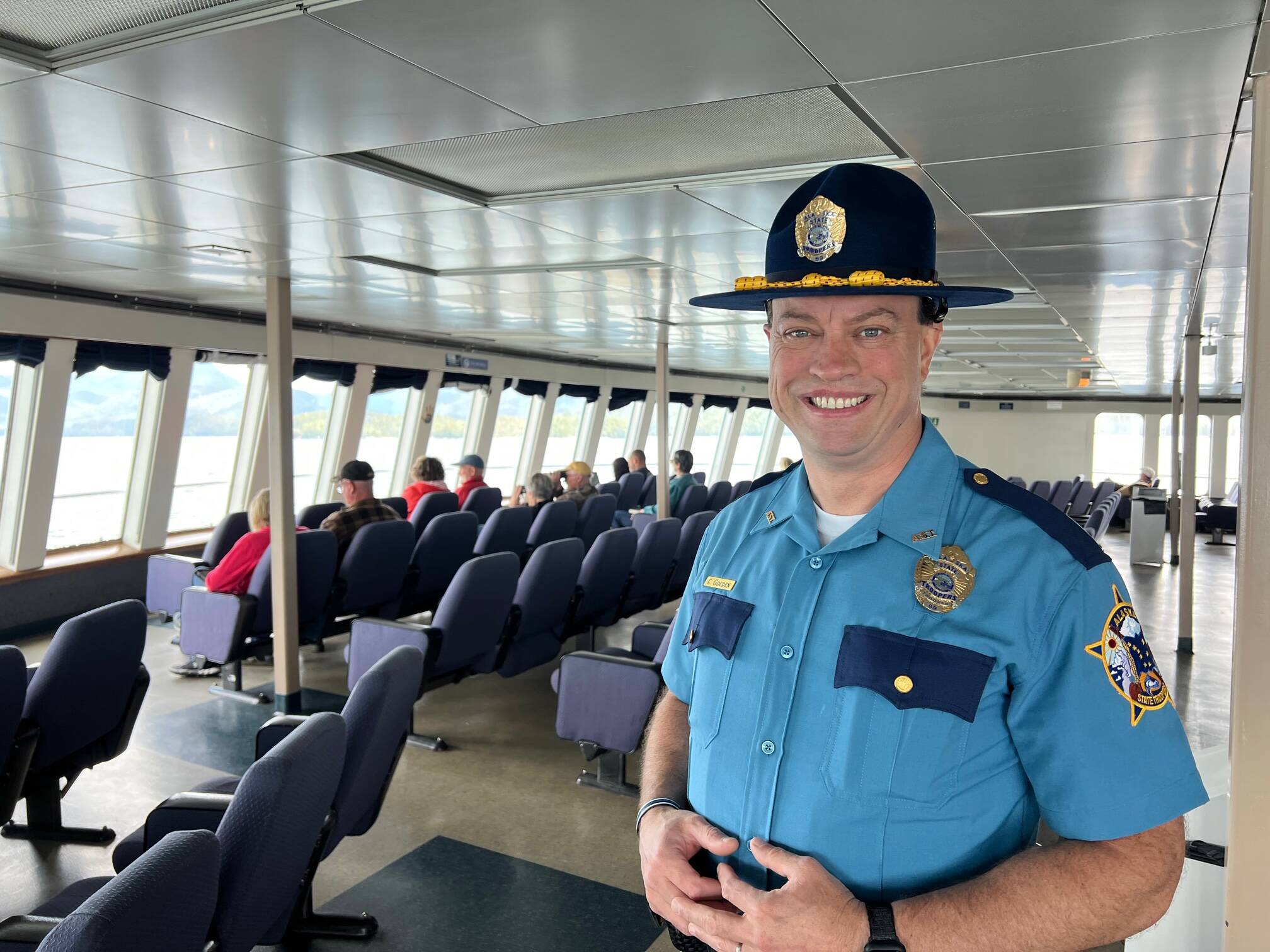This is part of the first segment of a two-part series about the tricky navigation facing the Alaska Marine Highway System.
A new $120,000 program that puts retired Alaska State Troopers in uniform on state ferries is already seeing results that are hard to measure: no incidents and an appreciative crew, which has long been tasked with overseeing the occasional unruly passenger.
“We’re here to make sure that people enjoy their trips, but don’t interfere with other people enjoying their trips,” said Trooper Chad Goeden, who was in uniform and stood out among passengers in casual clothes on the Columbia during the ferry’s three-day passage from Bellingham, Washington, to Ketchikan on July 14-17.
[Also in this series: Help wanted on the Alaska Marine Highway; Meet some of the crew on the Columbia]
High visibility is the point, because the aim of the program is as much to serve as a deterrent as to handle incidents, he said.
Only one trooper is actively on-duty on one Alaska Marine Highway System ferry at a time, and they could be on any one of the ships. Goeden, who served 24.5 years as a full-time trooper before his retirement, splits the position with Trooper John Brown. The program is different from a policy that allows troopers to travel for free on the ferry provided they are in uniform, Goeden said.
While proactive in nature, there are important reasons for the trooper on the ferry program, said Austin McDaniel, a spokesman for the Alaska Department of Public Safety, which coordinated with the Department of Transportation and Public Facilities in creating it.
“Alaska certainly has a drug trafficking problem and that is one of the modalities where people are trying to bring dangerous substances into Alaska,” McDaniel said.
Between 2012 and 2021 there were 1,382 drug overdoses in the state, or about 138 deaths per year. according to the Drug Overdose Mortality Update published in July of 2022 by the Division of Public Health at the Alaska Department of Health. In 2021, there were 253 overdose deaths, up from 146 in 2020,
There were 247 drug overdose deaths in Alaska in 2022, said Richard Raines, a research unit supervisor and analyst at DPH/ADH.
The fact the program hires retired troopers is an important detail, because it means it isn’t taking candidates away from other law enforcement jobs.
“We are short on troopers across the state, and being able to use unique programs and funding mechanisms like we’re doing with the ferry system makes a lot of sense,” McDaniel said.
“Between state and wildlife (divisions), which are uniformed, we are 60 troopers down,” McDaniel said, or about 10% of the workforce. It also saves money, because both Goeden and Trooper John Brown, who is also part of the program, already have paid benefits. Both are certified. He called the creation of the program an example of “thinking outside the box to solve a problem.”
Goeden summarized the origin of the trooper-on-the-ferry program as “DOT talking to DPS,” which was an exchange between the commissioners who lead the agencies —Ryan Anderson and James Cockrell, respectively.
“DPS didn’t have spare troopers but if DPS would create a new position, and DOT would pay for it, they could get it done,” Goeden said. The officers may be on any ferry route and at this point make their own schedules.
News of the program was welcomed by licensed and unlicensed crew in the wheelhouse of the Columbia.
“There was a time when they were sending chief mates to do that,” said Dave Butler, a licensed second mate working on board the Columbia during Goeden’s inaugural voyage. He and other wheelhouse crew joked about incidents from years earlier, most of them involving the bar.
Things are calmer now than in years past. The bar was shut down with budget cutbacks and COVID-19, but has since reopened on the Columbia with limited hours, and beer and wine only. But the added security is welcome.
Butler, who was working on “holdover” on the Columbia because of the staffing shortage, noted troopers are specially trained.
“As law enforcement, they know how to deal with the miscreant,” he said, adding the program doesn’t eliminate the responsibility of the captain and chief mate to manage incidents on board, and the paperwork that comes with it. “It does take some pressure off of crew.”
• Contact Meredith Jordan at meredith.jordan@juneauempire.com or (907) 615-3190.

